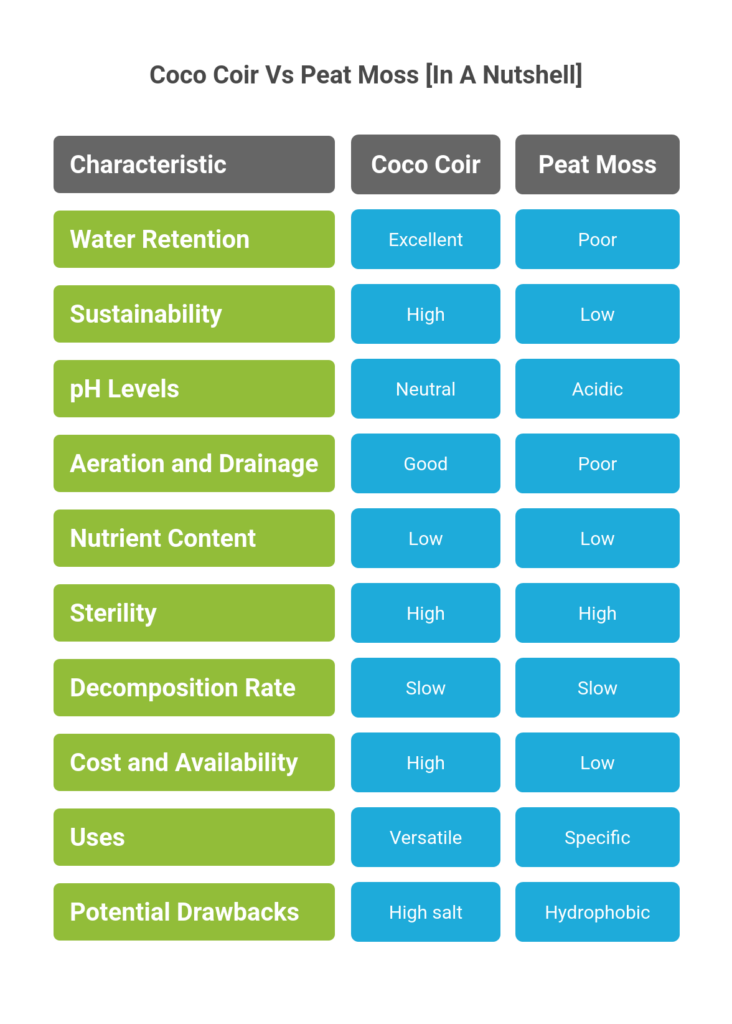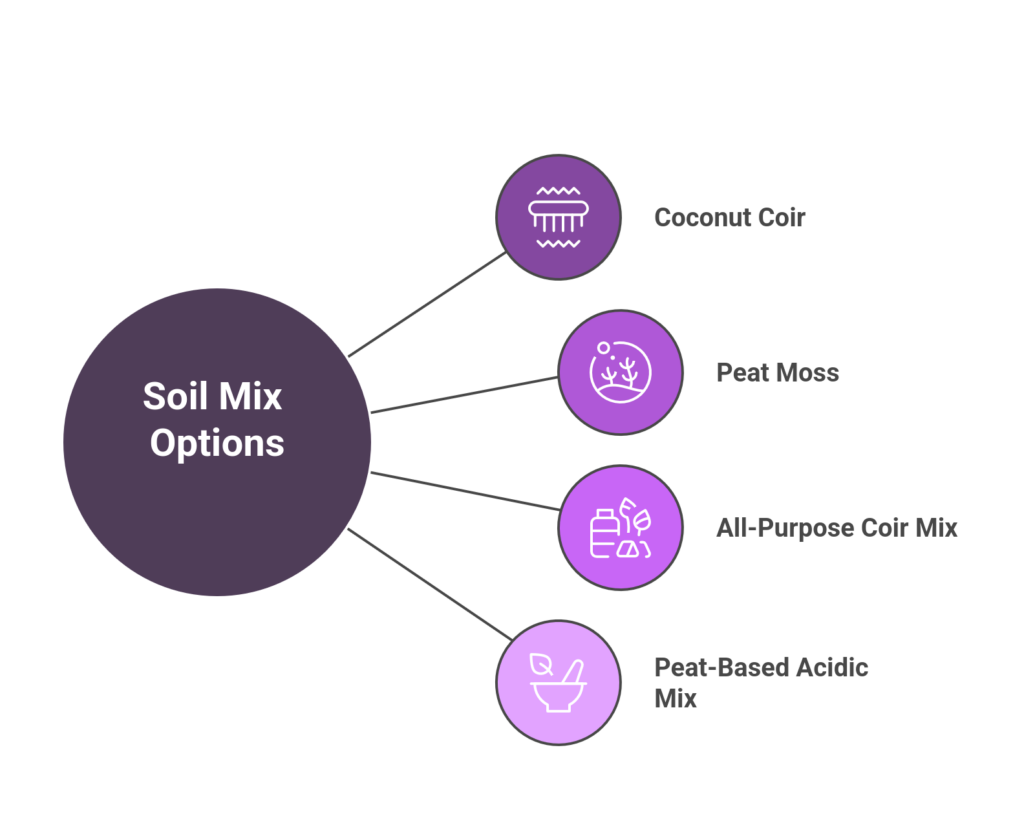We use affiliate links to run our site. When you buy through links on our site, we may earn an affiliate commission, without any added cost to you. Learn more
Did you know that millions of gardeners are unwittingly harming the environment with their soil choices? When it comes to creating a thriving garden, the type of growing medium you use can make all the difference. Coconut coir and peat moss are two popular options, but which one truly deserves a spot in your gardening toolkit?
This article will delve into the strengths and weaknesses of both materials, helping you make an informed decision that benefits your plants and the planet.
The Basics: What Even Are These Materials?
Let’s start with the “who’s who”.
Coconut Coir
Coconut coir is the ultimate recycling project. It’s made from the husks of coconuts—yes, the same ones that give us coconut water and piña colada toppings!
After the coconut’s edible parts are harvested, the fibrous husks are soaked, broken down, and transformed into a fluffy, soil-like material.
You’ll often find it sold as compact bricks that magically expand when watered (like a sponge, but less squeaky).
- Pre-Rinsed & Pre-Screened Coco Coir – Every block…
- Natural Soil Amendment for Plants – Coconut fiber…
- Excellent Moisture Retention – After expanding in…
Peat Moss
Peat moss, on the other hand, is like gardening’s ancient relic. It’s formed over thousands of years from decomposed sphagnum moss in waterlogged peat bogs.
Harvesting it involves draining these fragile ecosystems and vacuuming up the peat—a process that’s sparked major environmental concerns.
Fun fact: Some peat layers are older than the pyramids!
- You will receive 4 bags of peat moss per order
- Natural soil conditioner improves moisture retention and aeration in soils and potting mix
- Loosens heavy or clay soils for drainage and root development
Coco Coir vs Peat Moss
Now, let’s compare these two on factors that matter most to your garden:


Water Retention
Due to its unique fibre structure, coco coir can hold water up to ten times its weight, making it an overachiever. It even holds 30% more water than peat moss!
So, coir becomes an ideal choice for thirsty plants or dry climates. Plus, it rehydrates easily if it dries out.
Peat moss? It’s a bit moody. Once bone-dry, it becomes hydrophobic (water rolls right off!), which can leave roots parched.
Sustainability
Peat Moss:
Peat bogs are carbon vaults, storing more CO₂ than all the world’s forests combined. But when we harvest peat, we release that carbon and destroy habitats for rare species like carnivorous plants (RIP, Venus flytraps). Worse yet, peat bogs take centuries to regenerate. The UK has already proposed a complete ban on peat by 2030—a sign of the times.
Coconut Coir:
Coir gets a gold star for turning waste into wonder. Instead of burning coconut husks (a common practice), they’re repurposed into a renewable resource.
But it’s not perfect: Shipping coir from tropical regions adds to its carbon footprint, and some farms rely on monoculture practices. Still, it’s a step toward closing the sustainability loop.
Verdict: Coir wins for renewability, but peat lovers argue that responsibly harvested peat (from Canada’s vast bogs) can still have a place.
pH Levels
If you’re concerned about pH levels (which you should be!), coco coir usually sits around a near-neutral pH of 5.5 to 6.8, making it friendly for most plants. In comparison, peat moss is acidic with a pH between 3.5 and 4.5. This acidity can be great for plants that love acidic conditions, but may require lime to adjust it for others.
Aeration and Drainage
Coco coir strikes a perfect balance between keeping moisture and allowing air to flow through the soil. When mixed with materials like perlite or vermiculite, it enhances drainage and aeration even more.
In contrast, while peat moss retains moisture, it can stay soggy for too long, leading to drainage problems. If you’re dealing with clay soil, coco coir can loosen it up and improve drainage—something peat moss struggles with.
Nutrient Content
Here’s a critical point: coconut coir is mostly inert, meaning it lacks nutrients on its own. You’ll need to provide fertilizers to ensure your plants get what they need. However, it does have some potassium and micronutrients to offer.
On the other hand, peat moss is also low in nutrients but generally works well when mixed with nutrient-rich soil.
Sterility and Pest Resistance
In terms of cleanliness, coco coir is often seen as sterile, which helps prevent pests and diseases from taking root. It even contains substances that encourage beneficial bacteria growth! While peat moss is also typically sterile, it’s worth noting that regular soil can harbor pests and diseases.
Decomposition Rate and Longevity
Coco coir takes its time decomposing, which means it can stick around longer in your garden and be reused after a good rinse. Peat moss doesn’t break down quickly either, giving it longevity in your soil.
Cost and Availability
Let’s talk dollars: coconut coir can sometimes be pricier and harder to find than peat moss. However, because it’s often sold in compressed forms, shipping costs can be lower. Generally speaking, peat moss tends to be cheaper.
Uses
Both coconut coir and peat moss serve as excellent growing media in gardening. Whether you’re into container gardening or hydroponics, both materials have their place. Coco coir is particularly great for soilless setups like microgreens and wheatgrass, while peat moss shines in potting mixes and seed starters.
Potential Drawbacks
Now for some honesty—coconut coir might have high salt content, especially if processed with saltwater, so rinsing before use is essential. Also, because it’s inert, you’ll need to manage nutrients carefully; some experts suggest buffering it with calcium or magnesium. If it dries out completely, be ready for a soak session to rehydrate it!
Peat moss, meanwhile, can become hydrophobic when dry, making it tricky to rewet. Plus, its acidity might not suit every plant without some adjustments.
What’s Best for Your Garden?
After weighing the pros and cons, coconut coir seems to edge out peat moss in many aspects, especially when it comes to sustainability and ease of use. However, the best choice depends on your specific gardening needs.


Consider coconut coir if:
- You’re environmentally conscious.
- You struggle with remembering to water (it’s more forgiving!).
- You’re growing a variety of plants with different pH needs.
Stick with peat moss if:
- You’re growing acid-loving plants
- You live in an area where peat moss is locally sourced (reducing transport emissions)
- You’re on a tighter budget (peat moss is often cheaper)
DIY Soil Mixes to Try
All-Purpose Coir Mix:
- 2 parts coir
- 1 part compost
- 1 part perlite
- Perfect for raised beds and container gardens!
- NUTRIENT RICH & INDOOR/OUTDOOR FAST GERMINATION… Wonder Soil Premium Organic Potting Soil Mix is…
- A LITTLE DOES A LOT… your little BIG bag of compressed indoor potting soil & garden soil for…
Peat-Based Acidic Mix
- 1 part peat moss
- 1 part pine bark
- 1 part sand
- Blueberries will throw a fruit party in this!
- Optimal pH Balance: Expert blend, ideal acidic environment for azaleas, rhododendrons, and blueberries and more, ensures pH balance for growth and vibrant blooms
- All-Natural: Premium blend of natural ingredients promoting a healthy sustainable growing environment, eco-friendly mix, artisan-crafted in Kentucky
- Enhanced Drainage and Aeration: Includes perlite and sphagnum moss for optimal moisture balance and robust root development; improved nutrient absorption
- Natural Acidity Boost: Enriched with pine to enhance soil pH, letting your acid-loving plants thrive
- Ingredients: Peat moss, pine needle mulch, pine bark mulch, sphagnum moss and vermiculite
FAQs (Because You’re Probably Wondering…)
“Can I use coir instead of peat moss in recipes?”
Yes! Just add dolomite lime to balance pH if needed.
“Why does my coir smell… earthy?”
It’s normal! Unlike peat, coir has a mild, earthy scent—no “swampy” vibes.
“Is peat moss banned everywhere?”
Not yet, but many countries are phasing it out. Stock up wisely!
To Sum Up:
In conclusion, coconut coir generally takes the lead as a sustainable, neutral-pH alternative to peat moss. It’s great at retaining water and aerating soil, plus it’s easier to rehydrate when dry. But remember—it’s inert, so you’ll need to keep an eye on nutrient management and occasionally rinse away salts.
On the other hand, peat moss retains water well and stays sterile, but it’s more acidic and less sustainable in the long run. Choosing between coconut coir vs peat moss often boils down to your specific gardening needs and your commitment to environmental impact.
What I Think:
Coconut coir isn’t just a trendy alternative—it’s a step toward greener gardening. While peat moss still shines for specific plants, its environmental cost is hard to justify long-term. My advice? Start small: Swap peat for coir in one project (like seed starting) and see how it goes. Your garden—and the planet—might just thrive.
What’s your pick: Team Coir or Team Peat? Share your experiments below, and let’s grow this conversation! 🌿
Amazon and the Amazon logo are trademarks of Amazon.com, Inc, or its affiliates.


Hi there! My name is Prasenjit and I’m an avid gardener and someone who has grown a passion for growing plants. From my hands-on experience, I have learned what works and what doesn’t. Here I share everything I have learned.






